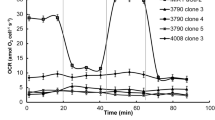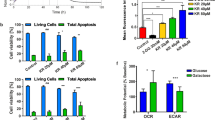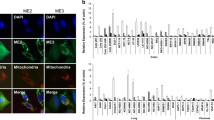Abstract
The mechanism of doxorubicin resistance induced by glucose deprivation was examined using an L929 cell system. Resistance developed even when the synthesis of glucose-regulated proteins was suppressed by supplementing glucose-deprived cultures with uridine. Resistance was also not correlated with pyruvate availability, with DNA strand breaks, or with intracellular drug or nucleotide levels. However, intracellular concentrations of reduced nicotinamide adenine dinucleotide phosphate (NADPH) decreased to undetectable levels in glucose-deprived cells with or without uridine supplementation. NADPH depletion induced by treating glucose-fed cells with low concentrations of methylene blue afforded the same degree of protection as glucose deprivation, and normal sensitivity could be restored to glucose-deprived cells by adding NADPH to the culture medium. These results suggest that decreased NADPH availability is responsible for the doxorubicin resistance induced by glucose deprivation. Although drug uptake and NADPH production increased with temperature, these effects could not fully account for the >1000-fold decrease in clonogenic survival observed over the 25°–27° C temperature range. Similarly, manipulation of NADPH levels confirmed a role for drug bioreduction in the cytotoxic mechanism but did not suggest that NADPH availability was rate-limiting for this process at any temperature employed.
Similar content being viewed by others
References
Anderson RJ, Babson JR (1989) Reduction of doxorubicin toxicity by methylene blue in cultured rat myocardial cells. Biochem Pharmacol 38:2568
Aubel-Sadron G, Londos-Gagliardi D (1984) Daunorubicin and doxorubicin, anthracycline antibiotics, aphysiological and biological review. Biochemie 66:333
Bachur NR, Gordon SL, Gee MV, Kon H (1979) NADPH cytochrome P-450 reductase activation of quinone anticancer agents to free-radicals. Proc Natl Acad Sci USA 76:954
Bachur NR, Moore AL, Bernstein JG, Liu A (1970) Tissue distribution and disposition of daunorubicin (NSC-82151) in mice: fluorometric and isotopic methods. Cancer Chemother Rep 54:89
Bates DA, Mackillop WJ (1986) Hyperthermia, Adriamycin transport, and Adriamycin cytotoxicity in drug-sensitive and-resistant Chinese hamster ovary cells. Cancer Res 46:5477
Bates DA, Mackillop WJ (1987) The relationship between membrane permeability to Adriamycin and cytotoxicity in CHO cells at elevated temperatures. Cancer Lett 38:129
Ganapathi R, Grabowski D (1988) Differential effect of the calmodulin inhibitor trifluoperazine in modulating cellular accumulation, retention and cytotoxicity of doxorubicin in progressively doxorubicin-resistant L1210 mouse leukemia cells. Lack of correlation between cellular doxorubicin levels and expression of resistance. Biochem Pharmacol 37:185
Goodman J, Hochstein P (1977) Generation of free-radicals and lipid peroxidation by redox cycling of Adriamycin and daunorubicin. Biochem Biophys Res Commun 77:797
Gullino PM, Grantham FH, Courtney AH (1967) Glucose consumption by transplanted tumors in vivo. Cancer Res 27:1031
Hahn GM, Braun J, Har-Kedar I (1975) Thermochemotherapy: synergism between hyperthermia (42°–43°) and Adriamycin (or bleomycin) in mammalian cell inactivation. Proc. Natl Acad Sci USA 72:937
Handa K, Sato S (1975) Generation of free-radicals of quinone group-containing anti-cancer chemicals in NADPH-microsome system as evidenced by initiation of sulfite oxidation. Jpn J Cancer Res 66:43
Hlatky L, Sachs RK, Alpen EL (1988) Joint oxygen-glucose deprivation as the cause of necrosis in a tumor analog. J Cell Physiol 134:167
Juliano RL, Ling V (1976) A surface glycoprotein modulating drug permeability in Chinese hamster cell mutants. Biochim Biophys Acta 455:152
Kanter PM, Schwartz HS (1982) A fluorescence enhancement assay for cellular DNA damage. Mol Pharmacol 22:145
Lanks KW (1986) Studies on the mechanism by which glutamine and heat shock increase lactate synthesis by L929 cells in the presence of insulin. J Cell Physiol 129:385
Lanks KW, Hitti IF Chin NW (1986) Substrate utilization for lactate and energy production by heat shocked L929 cells. J Cell Physiol 127:451
Lanks KW, Gao J-P, Kasambalides EJ (1988) Nucleoside restoration of heat resistance and suppression of glucose-regulated protein synthesis by glucose-deprived L929 cells. Cancer Res 48:1442
Lanks KW, Shah V, Chin NW (1986) Enhancing hyperthermic cytotoxicity by energy source restriction and insulin exposure. Cancer Res 46:1382
Lanks KW, Lehman JM (1990) DNA synthesis by L929 cells following doxorubicin exposure. Cancer Res 50:4776
Lanks KW (1987) End products of glucose and glutamine metabolism by L929 cells. J Biol Chem 262:10093
Lanks KW, Li P-W (1988) End products of glucose and glutamine metabolism by cultured cell lines. J Cell Physiol 135:151
McGrath T, Center MS (1987) Adriamycin resistance in HL60 cells in the absence of detectable P-glycoprotein. Biochem Biophys Res Commun 145:1171
Rice GC, Hahn GM (1987) Modulation of Adriamycin transport by hyperthermia as measured by fluorescence-activated cell sorting. Cancer Chemother Pharmacol 20:183
Shen J, Hughes C, Chao C, Cai J, Bartels C, Gessner T, Subjeck J (1987) Coinduction of glucose-regulated proteins and doxorubicin resistance in Chinese hamster cells. Proc Natl Acad Sci USA 84:3278
Shen JW, Subjeck JR, Lock RB, Ross WE (1989) Depletion of topoisomerase II in isolated nuclei during a glucose regulated stress response. Mol Cell Biol 9:3284
Sinha BK, Katki AG, Batist G, Cowan KH, Meyers CE (1987) Differential formation of hydroxyl radicals by Adriamycin in sensitive and resistant MCF-7 human breast tumor cells: implications for the mechanism of action. Biochemistry 26:3776
Stocchi V, Cucchiarini L, Magnani M, Chiarantini L, Palma P, Crescentini G (1985) Simultaneous extraction and reverse-phase high-performance liquid chromatographic determination of adenine and pyrimidine nucleotides in human red blood cells. Anal Biochem 146:118
Vichi P, Robison S, Tritton TR (1989) Temperature dependence of Adriamycin-induced DNA damage in L929 cells. Cancer Res 49:5575
Tweey KM, Rowe TC, Yand L, Halligan BD, Liu LF (1984) Adriamycin-induced DNA damage mediated by mammalian DNA topoisomerase II. Science 226:466
Wynants J, Van Belle H (1985) Single-run high-performance liquid chromatography of nucleotides, nucleosides, and major purine bases and its application to different tissue extracts. Anal Biochem 144:258
Yeh GC, Occhipinti SJ, Cowan KH, Chabner BA, Myers CE (1987) Adriamycin resistance in human tumor cells associated with marked alterations in the regulation of the hexose monophosphate shunt and its response to oxidant stress. Cancer Res 47:5994
Author information
Authors and Affiliations
Rights and permissions
About this article
Cite this article
Gao, JP., Friedman, S. & Lanks, K.W. The role of reduced nicotinamide adenine dinucleotide phosphate in glucose- and temperature-dependent doxorubicin cytotoxicity. Cancer Chemother. Pharmacol. 33, 191–196 (1993). https://doi.org/10.1007/BF00686215
Received:
Accepted:
Issue Date:
DOI: https://doi.org/10.1007/BF00686215




